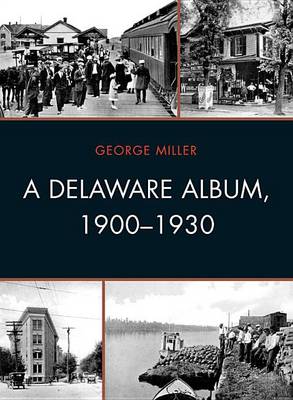Cultural Studies of Delaware and the Eastern Shore
1 total work
A Delaware Album, 1900-1930 contains over 300 postcard photographs from the entire state taken during the period from 1900 to 1930. Arranged by subjects-City and Town Views; Delaware Beaches; Amusements; Industry and Agriculture; Signs of the Times; Trains, Trolleys, and Automobiles; Water Transportation; Schools; Religion; Businesses; Hotels and Motels-each photo has a caption ranging from a sentence or two to several paragraphs. The book's introduction details how the cards were produced, analyzes the subject matter depicted on the cards, documents the history of several of the most prominent local photographers in the state whose work is found almost only on postcards, and traces the evolution and popularization of postcard photography.
Through the photographs readers can witness the development of Delaware agriculture and fisheries, the expansion of the railroad into southern Delaware, the declining days of steamship service on Delaware rivers and creeks, the fate of Middletown's last trolley, and Delaware's unsuccessful campaign against "King Alcohol." They can see how Delawareans worshiped, worked, and shopped. They can visit local amusement parks and beaches from New Castle county to Sussex county.
For the early decades of the twentieth century the postcard recorded every aspect of American life. As local historians will tell you, the photographic record of small town America during the period from 1900 to 1930 exists almost only on postcards. That is why historical societies, libraries, and museums have begun to amass postcard collections. In the last twenty years, historians and scholars have increasingly turned to the postcard as a way of seeing what our past literally looked like, what we enjoyed doing, where we worked and played, how we viewed one other, what we thought was important, and what prejudices we held.
Through the photographs readers can witness the development of Delaware agriculture and fisheries, the expansion of the railroad into southern Delaware, the declining days of steamship service on Delaware rivers and creeks, the fate of Middletown's last trolley, and Delaware's unsuccessful campaign against "King Alcohol." They can see how Delawareans worshiped, worked, and shopped. They can visit local amusement parks and beaches from New Castle county to Sussex county.
For the early decades of the twentieth century the postcard recorded every aspect of American life. As local historians will tell you, the photographic record of small town America during the period from 1900 to 1930 exists almost only on postcards. That is why historical societies, libraries, and museums have begun to amass postcard collections. In the last twenty years, historians and scholars have increasingly turned to the postcard as a way of seeing what our past literally looked like, what we enjoyed doing, where we worked and played, how we viewed one other, what we thought was important, and what prejudices we held.
